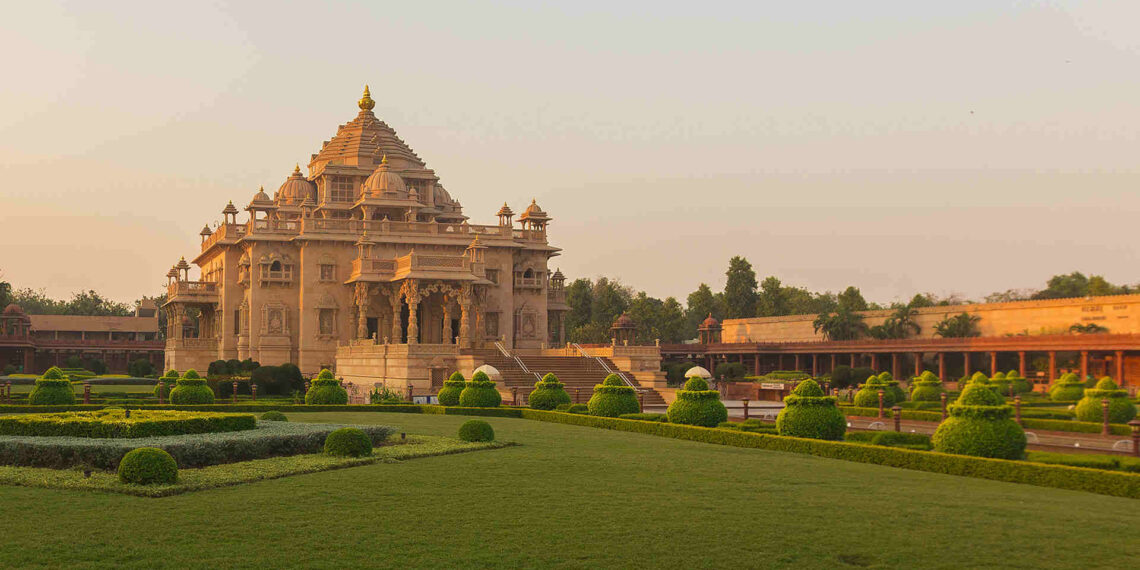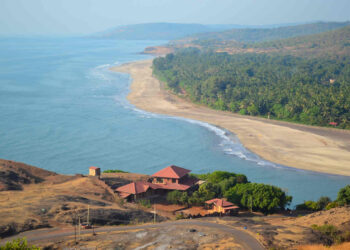Akshardham Temple is a grand shrine dedicated to Lord Swaminarayan, the founder of the Swaminarayan sect nestled in the heart of Gandhinagar, Gujarat. Built in 1992 by the Bochasanwasi Akshar Purushottam Swaminarayan Sanstha (BAPS), this modern temple, with its stunning carvings and vast gardens, draws devotees and visitors to its holy grounds. If you’re eager to explore this divine place, here’s a plain guide about its story, what it looks like, its prayers, and how to get there.
Fun Fact: The temple’s main idol, a 7-foot statue of Swaminarayan, is said to glow with a special light at dawn.
Mythological Importance
Akshardham Temple holds deep spiritual tales. One story says Lord Swaminarayan, born in 1781, was a divine soul who spread peace and devotion across Gujarat. Devotees believe he was an avatar of Vishnu, sent to guide people toward a pure life. Another tale tells of his travels as a young sage, blessing villages near Gandhinagar. Locals say praying here cleanses the heart and brings wisdom. As a key Swaminarayan shrine, it’s tied to his teachings of love and service.
Historical Overview
The temple was built in 1992 by BAPS, under the guidance of Pramukh Swami Maharaj. Gandhinagar, Gujarat’s capital, was chosen for its calm and central spot. The idea started in the 1980s, with devotees raising funds. Before this, Swaminarayan worship happened in small shrines since the 1800s. The temple’s opening saw lakhs gather, with prayers led by swamis. BAPS now runs it, keeping it clean and holy. In 2007, new exhibits were added, but the main shrine stayed untouched. Saints like Swaminarayan himself, who taught in Gujarat, made his sect famous. Today, it pulls thousands to Gandhinagar’s sacred land.
The temple’s past is tied to Swaminarayan’s legacy. Old records from the 1800s show his followers built small temples. British notes from that time praise his work for peace. Recent additions, like gardens, show BAPS’s care for the site.
Architecture of Akshardham Temple
Akshardham Temple, on 23 acres in Gandhinagar, is a modern take on Nagara-style architecture. The main shrine, built in 1992, has a pink sandstone dome with carvings of Swaminarayan, Vishnu, and lotus flowers. The sanctum holds a 7-foot gold-plated idol of Swaminarayan, seated with a calm smile, joined by idols of Gunatitanand Swami and Gopalanand Swami. The idols shine under soft lights. The sanctum’s walls have marble panels with Swaminarayan’s life stories.
The temple has a big hall with 200 pillars, each carved with saints and flowers. Smaller shrines for Radha-Krishna, Shiva-Parvati, and Lakshmi-Narayan are in the complex, made of white marble. The Radha-Krishna shrine shows them with flutes, for love. The Shiva-Parvati shrine has them in meditation, for peace. The Lakshmi-Narayan shrine shows them with lotuses, for wealth. The grounds, with green lawns and fountains, feel holy, shaded by neem trees. A stepwell, called Sahaj Anand, has carved steps for reflection. Low walls have small statues of swamis, said to guard the place. Carvings on pillars tell Swaminarayan’s teachings, guiding visitors. An exhibition hall shows his life through models and films.
Rituals and Festivals
The temple comes alive with holy festivals. Diwali, in October or November, is biggest, with lamps lighting the grounds and sweet offerings. Annakut, right after Diwali, has food displays for Swaminarayan. Swaminarayan Jayanti, in April, celebrates his birth with songs and prayers. Guru Purnima, in July, honors swamis with pujas. Janmashtami, in August, brings Krishna’s tales to life with dances.
Every day, the temple has its ways. Mangla aarti at dawn wakes the idols, then Abhishekam, with water and milk. Evening aarti, with lamps, ends the day. Special pujas, like Swaminarayan Homam, cost ₹100-500 and bring blessings. A stall gives free khichdi as prasad. Sunday pujas, with rose petals, seek calm and strength.
During Diwali, bhajans fill the air with joy. The stepwell, where folks meditate, gets busy during festivals with devotees seeking peace.
Information for Travelers
Hours and Entry: Open Tuesday to Sunday, 9:30 AM to 7:30 PM. Entry is free, but exhibits cost ₹60-200. Photos are okay outside, not in the sanctum.
Clothing: Wear clothes that cover shoulders and knees. Men for rituals wear kurtas, women wear sarees or suits.
How to Get There:
Air: Ahmedabad Airport, 25 km away, is closest. Taxis take 30 minutes, ₹500-800.
Train: Gandhinagar Capital Station, 5 km away, links to Ahmedabad (30 minutes) or Delhi (12 hours). Autos cost ₹50-100.
Road: Buses from Ahmedabad (30 minutes) or Vadodara (2 hours) reach Gandhinagar. Taxis cost ₹500-1000. The drive is smooth.
Places to Stay: Gandhinagar has guesthouses like Hotel Haveli (₹1000-2000). Hotels like Cambay Sapphire (₹3000-5000) offer comfort. Stalls sell dhokla, khaman, and tea.
Best Time to Visit: October to March is cool, 20-30°C. Weekdays are quiet. Diwali is busy, so book early.
Nearby Attractions:
Adalaj Stepwell, 15 km away, is an old carved well.
Sabarmati Ashram, 25 km away, is Gandhi’s home.
Indroda Nature Park, 5 km away, has dinosaurs and animals.
Dandi Kutir, 3 km away, is a Gandhi museum.
Sarita Udyan, 2 km away, is a peaceful garden.
Final Thoughts
Akshardham Temple in Gandhinagar, Gujarat, a holy spot in western India, is a gem of faith. The divine touch of Lord Swaminarayan fills its grounds, making it a place you’ve got to see among India’s sacred sites.











